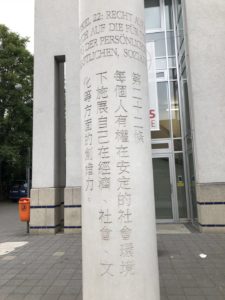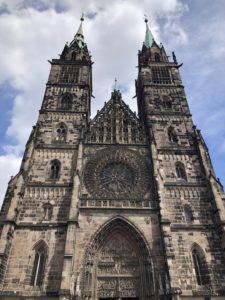1 hour away from Munich, there is a small medieval town called Dachau. Despite its peacefulness and beauty, shadows still shroud this town when we think about what happened here during Nazi Germany. In 1933, 8 weeks after Hitler became the Chancellor of Germany, the first concentration camp was built in Dachau. I visited there with two friends on May 31st.
On the bus to Dachau, our guide gave an introduction to the history behind it. On Feb 27th, 1933, Reichstag (German parliament building) was set on fire, which was later referred to as “Der Reichstagsbrand.” In order to destroy the German Communist Party, the second largest party in the parliament at that time, Hitler framed the case against the communists by saying that they were trying to rebel against the Weimar Republic. Soon he was able to disperse the party and Dachau was originally built to imprison the communists and socialists. Our guide emphasized that it took only 8 weeks for a democratic country to fall into dictatorship. Before then, the public considered Hitler as someone who loved children and had the ability to save Germany from the long-lasting economic crisis. A poster in the museum read, “Hitler, unsere letze Hoffnung! (Hitler, our last hope)”
From 1933 to 1945, this camp imprisoned people from 34 different countries and of various accusations: communists, liberals, monarchists, homosexuals, Gypsies, Jehovah’s witnesses, emigrants, asocials, and of course, the Jews. What those people share is that they lost all their human rights, properties, and human dignity when they stepped into this camp. On the gate of the entrance writes “Arbeit macht frei” (Work will set you free.), but the only way to be free from the torture here is actually through death. Today, it is hard for me to imagine that this large, empty ground was full of the imprisoned Jews and other criminals, standing there and waiting for a day of hard labor, torture or death.



 The edge of the ground is the greenfield, and beyond the greenfield and the iron fence is the boundless sky. I could not help wonder, how many people glazed at this sky with hope and longing for freedom? Among them, how many survived the massacre of Nazi before the end of the war and walked out of the gate? According to our guide, many people who could not bear the sufferings and humiliation ran to the Greenfield, the forbidden ground. As soon as the Nazi noticed their misbehavior from the tower, they were shot to death.
The edge of the ground is the greenfield, and beyond the greenfield and the iron fence is the boundless sky. I could not help wonder, how many people glazed at this sky with hope and longing for freedom? Among them, how many survived the massacre of Nazi before the end of the war and walked out of the gate? According to our guide, many people who could not bear the sufferings and humiliation ran to the Greenfield, the forbidden ground. As soon as the Nazi noticed their misbehavior from the tower, they were shot to death.



We visited the gas chamber. It was simple—people were told they finally got the chance to shower. They were required to take off all the clothes, went into the chamber and came out to the incinerator. I was shocked by how humans were treated no other than the animals in the slaughterhouse.

Not only the photos of the bodies of the victims but also the humanity they mirror are terrifying. 800,000 SS-Mann actively participated in the concentration camps to kill their nationals. Why could the humanity reach this extreme evilness? I could not help asking after the visit. This could not be explained solely by Hitler’s power.
“Wie viel toleranz braucht die Intoleranz? (How much tolerance does the intolerance need?)” I saw this slogan on my way to school every day. Nowadays, we global citizens all have the responsibility to reflect on the question and ensure the words on the memorial of Dachau, “Never again.”











